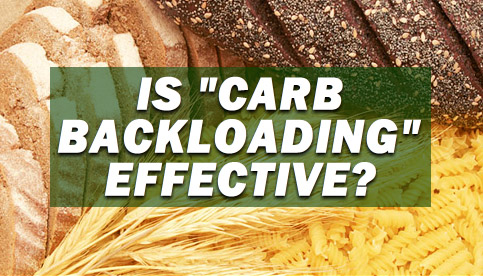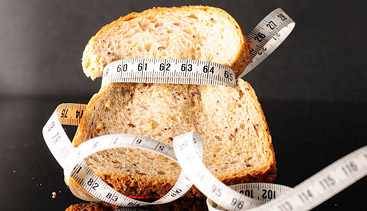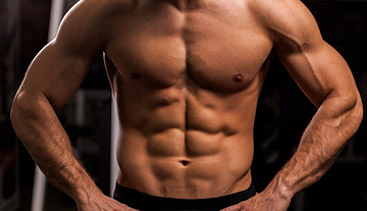IS THE “CARB BACKLOADING DIET” EFFECTIVE? THE NO B.S FACTS

For years, fat loss “nutrition experts” have been telling us that we should avoid eating carbs in the evening.
This is because metabolic rate naturally slows down in the later hours, and as a result, nighttime carbs are more likely to be stored as body fat.
Fortunately, with continued advances in nutritional science over the years (along with a bit of critical thinking), we now know that this simply isn’t the case.
As long as carb intake for the day as a whole remains the same, eating a higher percentage of them in the evening does not result in a greater amount of fat storage.
In fact, one of the latest dietary trends known as “carb backloading” proposes the exact opposite.
Consume virtually all of your daily carbs past 5pm, they say, and you’ll actually burn more total body fat while simultaneously building more lean muscle.
It all has to do with basing your carbohydrate intake on your body’s varying levels of insulin sensitivity at different times of the day – a method that will supposedly shuttle more glucose into your muscles where you want it and less into your fat cells.
But is there any real truth behind carb backloading, or is it just another over-hyped dietary gimmick like so many others that have come and gone over the years?
In today’s carb backloading review I’ll be explaining exactly what carb backloading is, how it’s claimed to work, what the research says about it, along with practical recommendations on whether or not it’s a worthwhile strategy to follow.
Let’s get started…
What Is Carb Backloading?

The basic concept of carb backloading has actually been around for decades, but it only took off in popularity in recent years when nutritionist and exercise scientist John Kiefer began recommending it.
The idea behind a carb backloading meal plan is as follows…
1) Keep your overall calorie and carbohydrate intake low during the morning and early afternoon, and then shift the majority of your intake to the evening hours.
2) If you do eat during the morning or midday, keep your carb intake at an absolute minimum and get the majority of the calories from protein and fat.
3) Move your training session to the early evening around 5pm, and consume most (or all) of your daily carbohydrates beginning with your post workout meal and throughout the rest of the evening.
How Does Carb Backloading Work?

The basic goal of the carb backloading diet is to shuttle a greater percentage of the glucose you consume into your muscle cells and less of it into your fat cells.
As a result, you build lean mass more effectively while stripping off unwanted body fat.
This is accomplished by taking advantage of the body’s varying levels of insulin sensitivity at different times of the day.
First off, insulin sensitivity in both muscle and fat tissue is naturally higher in the morning and afternoon in comparison to the evening. This means that both tissues are more receptive to glucose during this time.
Secondly, insulin sensitivity is higher in muscle cells in the hours following an intensive workout.
So, by restricting carbohydrate intake in the earlier hours of the day, you’ll be less likely to gain body fat since insulin sensitivity in fat tissue is higher during that time.
Then, as insulin sensitivity in fat tissue begins to drop in the early evening, you perform your workout in order to specifically “spike” the insulin sensitivity in your muscle cells.
Once your workout is over, you begin consuming most (or all) of your daily carbs.
Since insulin sensitivity is now high in your muscle cells and low in your fat cells, a higher amount of that glucose will be stored in your muscles as glycogen rather than as body fat.
It sounds pretty convincing in theory, but does carb backloading work in the real world when it comes to maximizing fat loss and muscle growth?
Is it superior to a standard diet where macronutrients are more evenly distributed throughout the day?
Is Carb Backloading Effective In The Real World?

Despite all of the hype surrounding the carb backloading diet, there really are only two concrete studies available to support its benefits.
These are cited quite frequently throughout Kiefer’s carb backloading manual.
The first study was conducted on a group of police officers over a 6 month period and compared the effects of consuming carbs evenly throughout the day versus mostly at dinner. (1)
The officers followed a 1300-1500 calorie diet consisting of 40-50% carbohydrates, 20% protein and 30-35% fat.
The group following the carb backloading meal plan lost more total body fat and experienced a greater reduction in waist circumference.
Sounds good on paper, but there are a few important catches here.
First off, the overall difference was fairly minor at just 5.5 pounds of additional body fat lost over a 6 month period, or about 0.2 pounds per week.
In addition, the study contained several key methodological flaws that call the results seriously into question, if not rendering them altogether meaningless.
For one, calorie intake was self-reported.
This is a huge factor to take into account, as the research is very clear in showing that most fat loss dieters are notoriously bad at tracking their intake accurately. (2, 3, 4, 5, 6)
Police offers also lead a generally hectic lifestyle, opening the door for even more possible tracking errors.
In addition, protein intake was exceptionally low.
At only 65-75 grams per day (the average weight of the participants was 216 pounds), they were consuming far less than what someone looking to gain muscle and lose fat optimally would be eating.
So, given that the overall difference in fat loss was minor and that the study was poorly designed (not to mention that no structured exercise plan was in place either), this study doesn’t say much (if anything) about the benefits of carb backloading.
The second study involved 10 participants and compared the difference between consuming 70% of total calories in the morning versus the evening on overall body mass and body composition. (7)
The diets consisted of 60% carbohydrates, 18% protein and 22% fat and were carried out over a 6 week period.
The results showed that shifting the majority of calories further into the evening resulted in a greater amount of fat loss and improved the preservation of lean muscle as well.
The upside to this study in comparison to the previous one is that food intake was strictly controlled, and the participants also underwent a structured weight training and cardio plan, making the results more applicable to a fitness-oriented population.
The downside?
Body composition was measured using a method known as “total body electrical conductivity”, which is quite unreliable and subject to a large margin for error. (8)
Not only does this decrease the reliability of the results pretty significantly, but the very small sample size of only 10 participants also makes the outcome much harder to quantify.
As you can see, in terms of reliable, concrete research, the carb backloading diet really doesn’t have much going for it.
In fact, several studies have even shown the opposite of what carb backloading proponents claim by demonstrating that as long as total calories for the day remain the same, the specific way in which those calories are spaced out will have no significant impact on overall fat loss. (9, 10, 11, 12, 13)
Regardless of whether you eat 2 big meals, 4 medium sized meals or 6 small meals – and whether you shift a higher percentage of your food intake to the morning/afternoon or evening/night – both basal metabolic rate and the thermic effect of food remain unchanged.
What about the claim that carb backloading builds muscle more effectively due to the increased carbohydrate intake during the post workout period?
The research on this topic has also found a few interesting things…
First off, consuming an essential amino acid mixture along with a large serving of carbs (90 grams) did not have a greater effect on protein synthesis in comparison to pairing the amino acids with a smaller serving of carbs (30 grams) after a leg workout. (14)
In other words, if carbohydrates do improve muscle growth when consumed post workout, you don’t need a huge amount of them in order to reap the benefits.
Not only that, but it’s not even clear whether or not carbohydrates are necessary at all during the post workout period when it comes to stimulating muscle growth.
Researchers from the Netherlands looked at the effects of consuming post workout protein with either 0, 0.15, or 0.6 grams of carbohydrates per kilogram of body weight in a group of healthy trained men. (15)
Once again, overall protein synthesis was found to be the same between all groups.
What about the issue of glycogen replenishment?
Well, unless you’re performing exhaustive endurance work, glycogen levels will only be depleted by about 30-40% after a typical weight training session.
So, unless you’re a hard-training athlete who was planning to train the same muscle groups again in the next 24 hours or so, this is really of no practical concern.
By simply finishing your workout and resuming your regular eating plan, those glycogen levels will be naturally re-elevated over the next few meals, well in time for your next workout.
It’s not that replenishing glycogen levels isn’t important – it’s just that there’s no need to do it immediately post workout by consuming “fast acting carbs” like the carb backloading diet recommends.
The Possible Benefits Of Carb Backloading

When taking all of the available research into account, it doesn’t appear that the carb backloading diet possesses any unique fat burning or muscle building benefits.
All we have are two pretty heavily flawed studies, and only one of those studies specifically dealt with shifting carbohydrate intake rather than just total calories.
However, this doesn’t mean that carb backloading “doesn’t work” or that certain individuals can’t benefit from it.
When it all comes down to it, proper fat burning and muscle building nutrition is primarily an issue of meeting your total calorie and macronutrient needs for the day as a whole.
The specific way in which you space your meals out is of far less importance as long as the numbers all add up in the big picture.
For that reason, any particular diet structure that allows you to meet your overall daily nutritional needs will ultimately be successful.
So, if a particular style of eating works better for you personally in terms of controlling appetite, fitting into your schedule or just being a more enjoyable way to eat, that’s probably the diet plan you should be following.
And for some people, shifting a higher percentage of total calories and carbohydrates into the later hours of the day (as the carb backloading diet recommends) is the more preferred way.
There are a few possible reasons why this approach can be a good fit for some people…
1) They’re able to hit their overall calorie and macronutrient targets more closely, since allotting more of their calories into a shorter eating window reduces their appetite and decreases the chances of over-eating.
2) They enjoy the physical and mental satisfaction that comes with eating larger portions of carbohydrates in a shorter period of time rather than spacing them out into smaller feedings.
3) They find that their overall diet becomes simplified since they’re able to spend less time thinking about food and having to plan out meals in the earlier portions of the day.
4) They tend to get particularly hungry after workouts, and thus consuming more food during the post workout period at the expense of eating earlier on makes sense.
If any of these points apply to you, then a carb backloading meal plan (or something similar such as intermittent fasting which focuses on shifting total calories rather than just carbs) may be a viable dieting approach for you.
You can either follow the standard carb backloading protocol exactly as outlined, or do a modified version by simply moving a bit more of your daily carb intake to the later hours but not completely restricting them in the morning/afternoon.
Carb Backloading Review: The Bottom Line

If allotting a higher percentage of your carb intake into the evening hours fits better with your personal preferences and lifestyle, by all means go for it.
All things equal, whatever specific eating structure maximizes your mood, energy levels, motivation and that controls your appetite most effectively is going to lead to the greatest long term results.
However, if you prefer spacing your calories and carbs out more evenly during the day, switching to a carb backloading diet likely won’t make any real noticeable difference to your overall body composition.
It doesn’t appear to have any special benefits for losing fat or building muscle, and total calorie and macronutrient intake for the day as a whole is by far the most important factor that will determine your bottom line results.
Carb backloading is simply one option out of many different possible options when it comes to laying out your meals for the day, and whether or not you should follow it ultimately comes down to a matter of personal preference.
If you found this carb backloading review helpful, make sure to get your personalized training, nutrition and supplement plans using my free interactive video presentation below…
If you found this article helpful, make sure to sign up for your FREE custom fitness plan below...




